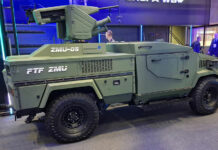General Atomics Aeronautical Systems, Inc. (GA ASI) has demonstrated employing the Predator B Remotely Piloted Aircraft (RPA) drone on Electronic Attack missions. Two demonstrations were performed at the U.S. Marine Corps’ (USMC’s) Weapons and Tactics Instructor course held at Marine Corp Air Station (MCAS) Yuma on October 22. This second demonstration expanded on the success of previous efforts between the Marine Corps, Northrop Grumman Corporation, and GA-ASI.
The objective was to integrate a company-owned Predator B RPA into a Marine Aviation Command and Control (C2) network, enabling control of the aircraft’s Electronic Warfare (EW) payload and other assets to deliver effects across the Electro-magnetic Spectrum (EMS). This C2 capability was exercised from the Cyber/Electronic Warfare Coordination Cell located at MCAS Yuma and addressed simulated targets located hundreds of miles north at Naval Air Weapons Station China Lake. The Marine Corps is currently analyzing the jamming data in an effort to quantify the EW effectiveness better and hopes to have the official results available soon.
The US Air Force has also developed an EA attack capability for its MQ-9 Reaper RPAs. These assets were aimed primarily at communications and improvised
explosive device jamming. This program has also encountered potential electromagnetic interference issues caused by the jamming pod that could interfere with the aircraft’s communications link to ground station controllers. The Air Force canceled this program in its fiscal year 2013 budget submission, before these concerns were addressed.
In 2009 Chesapeake Technology International Corporation (CTI) and AeroMech Engineering, Incorporated (AME – later acquired by Lockheed Martin) team successfully demonstrated an unmanned airborne high powered communications Electronic Attack (EA) capability, using the AME’s Fury UAS system. Another system designed by the company later supported the Marine Corps’ ‘Intrepid Tiger II’ (ALQ-231) providing a podded lightweight EA payload designed for the AV-8B and RQ-7B unmanned aerial vehicle. The AN/ALQ-231(V) was the first weapon system to include the Electronic Warfare Services Architecture (EWSA) capability. This allows the weapon to not only be controlled from within the host platforms cockpit, but also via a tactical secure radio network. This allows for the weapon to be hosted on non-traditional EW platforms, or hosting a system on board the aircraft, without adding workload on the part of the platforms aircrew. The Interpid Tiger II was first deployed with the Harrier II squadron VMA-211 since 2012, on its recent deployment in Afghanistan. While this capability proved highly desirable for use with unmanned systems, initial testing of the UAS-configured pod revealed electromagnetic interference with the RQ-7B’s safety of flight systems.
The US Army opted to field its electronic attack payloads on its MQ-1C Gray Eagle unmanned aircraft systems. The first two systems were delivered earlier this year to support of the Army’s Networked Electronic Warfare, Remotely Operated (NERO) system. These payloads were developed by Raytheon, and delivered in May 2013 as part of a contract awarded by Navy NAVSEA-Crane in 2012. NERO is utilized on the Gray Eagle as an airborne electronic attack system capable of providing beyond-line-of-sight jamming capability to support ground troop operations.
The NERO system builds on the Army’s Communications Electronic Attack with Surveillance and Reconnaissance (CEASAR) program. CEASAR aims to support tactical ground forces by denying and disrupting enemy communications systems and improvised explosive devices. By migrating the same pod system and advanced capability to the Gray Eagle, NERO is capable of two- to three-times longer missions with reduced operating costs compared to it’s current application on a manned twin-engine Beechcraft King Air C-12 aircraft. CEASAR was first awarded in 2010.
“NERO provides critical jamming capabilities to warfighters in counterinsurgency environments,” said Glen Bassett, director of Advanced Communications and Countermeasures for Raytheon’s Space and Airborne Systems business. “We leveraged our combat-proven success from the manned CEASAR program to deliver this key tactical electronic attack capability onto an unmanned application.”

















